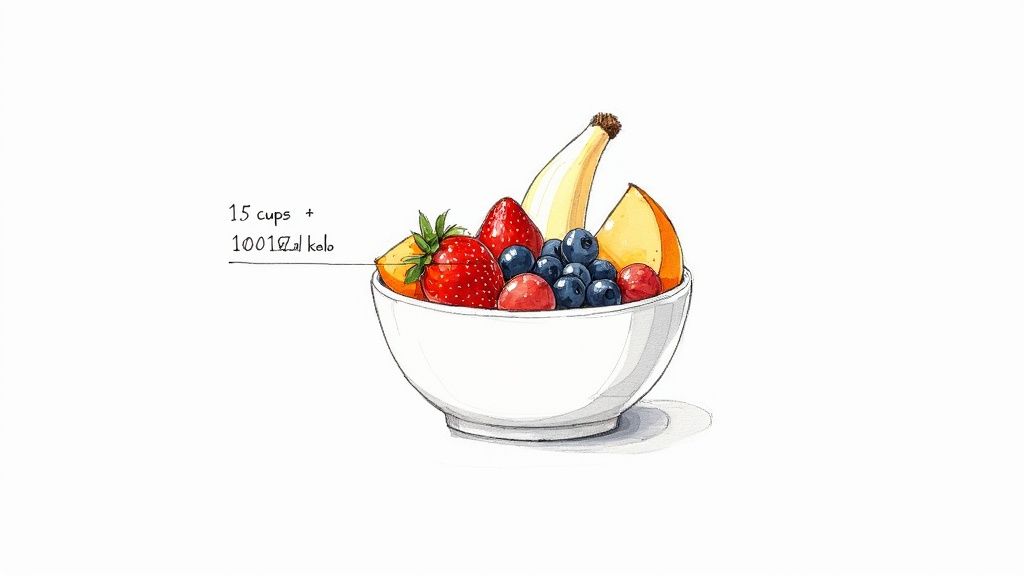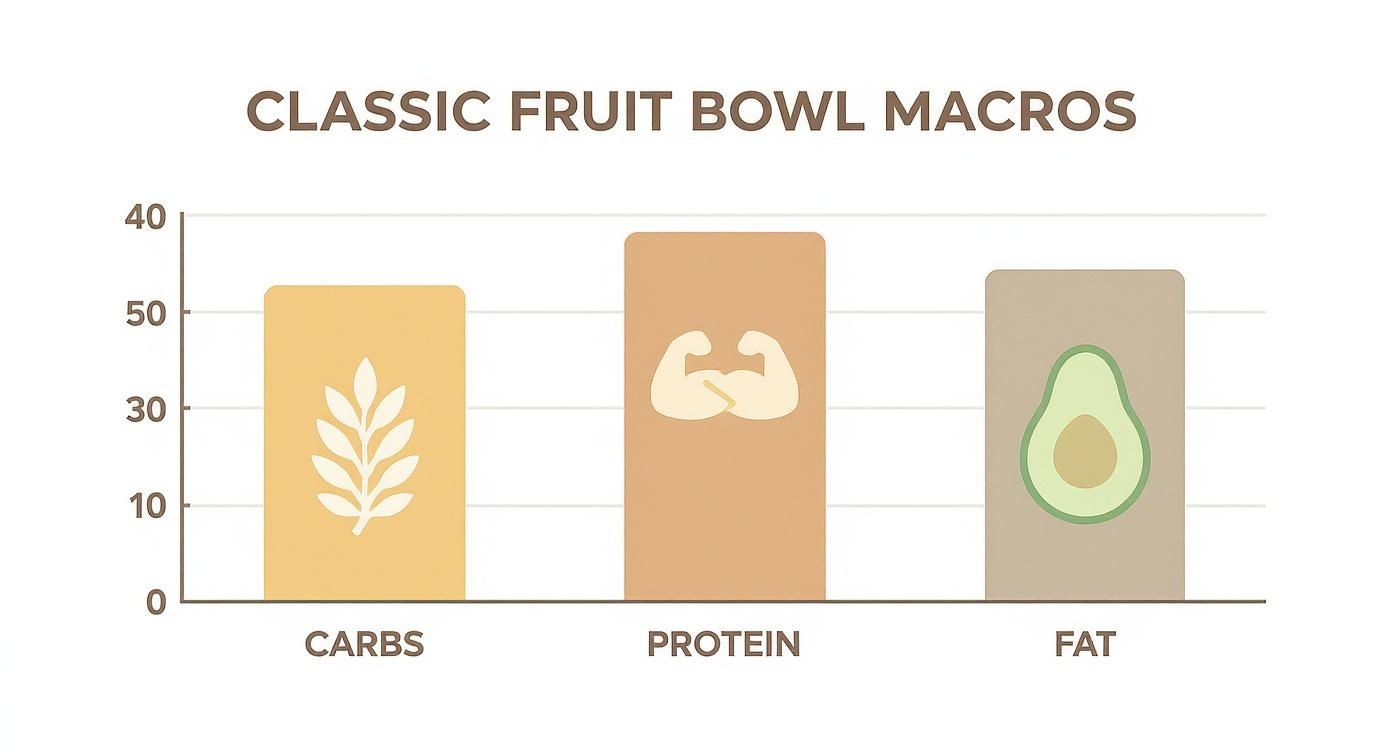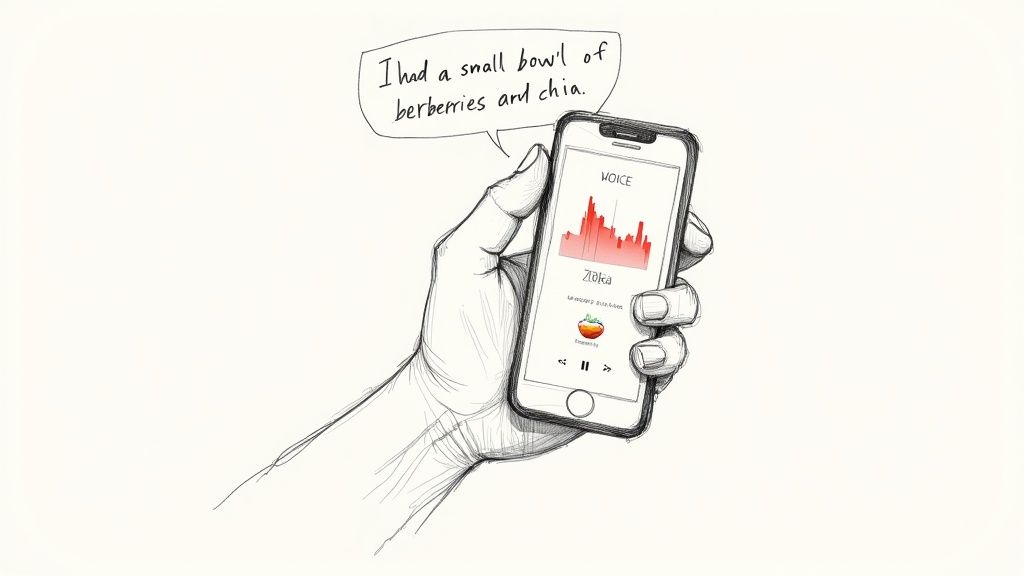Your Guide to the Calories in a Fruit Bowl: Smart & Tasty Bowls
Curious about calories fruit bowl? Learn a clear breakdown of fruits, toppings, and portions to build tasty bowls that fit your goals.
Posted by
Ever wonder about the calorie count in that beautiful, vibrant fruit bowl you're about to dig into? For a standard 1.5-cup bowl filled with a mix of berries, melon, and maybe some banana, you're typically looking at somewhere between 100 and 150 calories.
But that's just the starting point. The real story of a fruit bowl goes way beyond just a number. It's about getting clean, nutrient-packed energy and feeling genuinely satisfied.
Why a Fruit Bowl Is Such a Smart Choice

Thinking about the calories in your fruit bowl is a great way to be mindful of what you're eating without getting lost in complicated diet rules. A bowl of fresh fruit is naturally full of vitamins, water, and fiber, making it an awesome choice for anyone who wants to feel energized and just plain good.
Unlike a processed snack that might leave you hungry an hour later, the fiber in whole fruit slows down digestion. This is a total game-changer. It means you feel fuller for longer, which is a huge help when you're trying to manage your appetite and avoid those mindless afternoon snack attacks.
The Science Behind Feeling Full
It all comes down to a powerful combo: low energy density (which just means fewer calories for its weight) and high fiber content. This is what makes fruit so great at satisfying hunger.
Research has shown that eating more whole fruit can help with maintaining weight or even contribute to a little weight loss—even with the natural sugars. The complete package of fiber, water, and essential nutrients creates a fulfilling meal that helps you stay on track without ever feeling like you're missing out. You can dive deeper into the science by checking out this detailed study on the role of fruit consumption.
Tracking Made Simple with Voice
And here's the best part: you don't need a scale or a calculator to keep an eye on your nutrition. With an app like munchlog.ai, you can just say, “I had a bowl of mixed berries and banana for breakfast,” and the AI takes care of the logging. This turns tracking from a chore into a quick, simple check-in.
It's all about building awareness, not creating stress. When you understand what's in your food, you can make choices that line up with your goals and make you feel great. Whether it's a quick breakfast or a refreshing afternoon pick-me-up, a fruit bowl is way more than its calorie count. It’s a simple, delicious step toward a more balanced lifestyle.
Breaking Down a Classic Fruit Bowl
Let's look at a real-world example. Picture a classic fruit bowl, the kind you’d find at a café or mix up at home: a simple combo of strawberries, blueberries, banana, and melon. The goal here isn't to get lost in tiny details; it's to get a solid feel for what you're eating.
A typical 1.5-cup serving of this mix is a fantastic choice. It’s vibrant, packed with different textures, and gives you a nice, clean energy boost—without the crash you get from processed snacks. It's just good, honest food.
What’s Inside A Typical Serving
So, what does that bowl actually look like from a numbers perspective? For our classic mix, the breakdown is pretty straightforward. Most of the calories in a fruit bowl come from carbohydrates, which are your body's favorite fuel source.
A standard 1.5-cup bowl with berries, melon, and banana will usually land somewhere between 130-150 calories. This includes about 30-35 grams of carbohydrates, with almost no fat and a little bit of protein.
This macro profile makes it a perfect breakfast or snack. The carbs give you that immediate lift, while the fiber—which comes right alongside the natural sugars—helps ensure that energy is released slowly and steadily. If you want to dive deeper, you can explore the specific perks of berries in our guide to mixed berries nutrition facts.
Macros at a Glance
Let's quickly look at what each of those macronutrients is doing for you. Think of them as players on a team, each with a specific role.
- Carbohydrates (The Energizer): This is the star of the show. The 30-35 grams of carbs come from natural sugars (fructose) and fiber. They provide that quick-yet-sustained energy you need to power through your morning or kick an afternoon slump.
- Protein (The Builder): Fruit isn't a protein heavyweight, but you can still expect about 1-2 grams in a typical bowl. It's a small contribution, but every little bit helps.
- Fat (The Sustainer): A basic fruit bowl is naturally super low in fat, usually with less than 1 gram. This is what keeps it feeling light and easy to digest.
Logging this with munchlog.ai is as simple as it gets. Instead of painstakingly typing out "half a cup of strawberries, a quarter cup of blueberries, half a banana," you can just say, "I had a fruit bowl with berries, banana, and melon." Our AI estimates the nutrition for you, giving you a clear picture of your meal in seconds. It’s all about staying mindful without the manual effort.
How Toppings Change Your Calorie Count
A simple bowl of fruit is a fantastic, low-calorie start. But let’s be real—the toppings are what take it to the next level. A sprinkle of granola for crunch, a spoonful of creamy yogurt, or a drizzle of honey can turn a humble snack into something truly satisfying.
Of course, those delicious additions are also where the calories can quietly add up. This isn’t about making your favorite mix-ins the bad guy. It's about knowing what you're adding so you can build a bowl that perfectly fits your goals, whether that’s a light snack or a full-blown meal.
This infographic gives you a baseline, showing the typical macro breakdown for a bowl of just fruit.

As you can see, without any extras, it's almost all carbs. The protein and fat are minimal, which is where toppings come in to create a more balanced meal.
The Calorie Cost of Common Toppings
To see just how much toppings can change things, let's compare some popular choices. A small addition might seem like no big deal, but it can dramatically alter the final calorie, protein, and sugar content of your bowl.
| Topping (Serving Size) | Added Calories (Approx.) | Added Protein (g) | Added Sugar (g) |
|---|---|---|---|
| Chia Seeds (1 tbsp) | 60 | 2 | 0 |
| Almonds, Sliced (2 tbsp) | 85 | 3 | 1 |
| Granola, Standard (1/4 cup) | 120 | 3 | 10 |
| Greek Yogurt, Plain (1/2 cup) | 90 | 16 | 4 |
| Honey (1 tbsp) | 65 | 0 | 17 |
| Chocolate Chips (1 tbsp) | 70 | <1 | 9 |
As you can see, there's no single "best" choice—it all depends on what you're aiming for. Greek yogurt is a protein powerhouse, while honey delivers a quick hit of sugary energy.
The most impactful decision you can make is choosing toppings that align with your goals. A scoop of protein-rich Greek yogurt turns your fruit bowl into a powerful post-workout meal, while a handful of nuts adds sustained energy for a busy morning.
Logging Your Toppings Effortlessly
This is where casual tracking really shines. You don't need to get out the food scale for every sprinkle of seeds or spoonful of yogurt. With a tool like munchlog.ai, you can just add to your original voice log.
Simply say, "...and I added a handful of granola and a spoonful of yogurt." The AI instantly adjusts the estimates, giving you a more accurate picture of your meal's calories and macros in seconds. It’s a completely friction-free way to stay aware of your choices, making it that much easier to build the perfect fruit bowl for any occasion.
Making Your Fruit Bowl Work for You
Think of your fruit bowl as a blank canvas. It’s not just a static recipe—it’s a flexible starting point you can adjust to fit whatever your body needs, whether that’s post-workout fuel or a light afternoon snack. This is your chance to get creative and make your food work for you.
The real goal isn't just to eat more fruit, but to eat it with intention. While health guidelines generally recommend about one cup-equivalent of fruit for every 1,000 calories you eat, most people aren't quite there yet. One survey even showed that total fruit intake in the U.S. dropped by 7% over a 14-year period. You can dig into the data on U.S. fruit consumption trends on ers.usda.gov. Customizing your bowl makes hitting those targets feel less like a chore and more like a treat.
Building for Energy and Recovery
Just crushed a workout? Your muscles need repair and your energy is tapped out. This is the perfect time to turn your fruit bowl into a powerhouse meal by adding a dose of protein.
- For Post-Workout Recovery: A big scoop of plain Greek yogurt is a game-changer, adding a solid 15-20 grams of protein to kickstart muscle repair. A scoop of your favorite protein powder mixed in works just as well.
- For Lasting Morning Energy: If you need breakfast to carry you all the way to lunch, healthy fats are your best friend. A quarter of an avocado or a handful of walnuts adds a creamy texture and slow-burning fuel to prevent that dreaded mid-morning crash.
Logging these extras is a breeze with Munchlog. Simply say, "I had a fruit bowl with Greek yogurt and walnuts," and the app does the rest. If you're still getting the hang of portion sizes, our guide on how to weigh food for weight loss has some great tips to get you started.
Crafting a Lighter Snack
Sometimes you don't need a full meal—just a light, refreshing pick-me-up. For those moments, you can build a bowl focused on high-volume, lower-sugar fruits that satisfy cravings without weighing you down.
Choose fruits with high water content. Watermelon, cantaloupe, strawberries, and raspberries give you a lot of food for fewer calories, making your snack feel more substantial.
This strategy is perfect for an afternoon treat that won't ruin your appetite for dinner. If you're following a specific eating plan, like a ketogenic diet where carb counts are critical, resources providing Keto meal plans can be invaluable for making smart fruit choices.
By tracking your custom creations, you’ll quickly learn which combinations leave you feeling energized and at your best.
Voice Logging Your Fruit Bowl in Seconds

Okay, we’ve covered how to build the perfect fruit bowl for your goals. But what about actually tracking it? Let’s be honest: manually typing out "half a cup of strawberries, one-quarter cup of blueberries, two tablespoons of granola" is the kind of boring task that makes most of us quit food logging altogether.
This is where voice logging feels like magic. It’s designed to be completely effortless, turning what used to be a chore into a quick, two-second habit. The whole idea is to capture what you ate without breaking your stride.
The technology that makes this possible is efficient audio-to-text conversion, which lets you just speak your meal into existence in your log. It closes the gap between eating and recording.
How It Works in Real Life
Forget opening a clunky app, tapping through menus, and searching for every single item. With munchlog.ai, you just talk to it like you're leaving a quick voice memo. The AI does the heavy lifting, figuring out the calories and macros from your description. This isn't about being perfectly precise; it's about being mindful.
Here’s what that looks like in practice:
- For a simple snack: Just say, "I had a small bowl of strawberries and blueberries with some chia seeds."
- For a bigger breakfast: Try, "My breakfast was a big fruit bowl with Greek yogurt, granola, and a little honey."
- For a custom creation: You could say, "I ate a bowl of watermelon and pineapple with a handful of almonds on top."
In every scenario, munchlog.ai instantly translates your spoken words into a nutritional snapshot. No food databases to navigate, no barcodes to scan, and no need to weigh your portions unless you really want to.
Stay Consistent Without the Stress
This hands-free approach is what makes tracking a sustainable habit, especially when you're busy. When logging is as easy as talking, it stops feeling like another task on your to-do list and becomes second nature.
The real goal of food tracking isn’t to be scientifically accurate every single day. It's to build awareness. Effortless logging helps you spot patterns, empowering you to make small, positive changes over time.
You're basically creating a personal food journal just by talking about your meals. If you want to see how this fits into a bigger picture, check out our guide to finding a simple food diary app that actually works for you. At the end of the day, the best tool is the one you’ll actually use, and voice makes consistency easier than ever.
Smart Fruit Choices On The Go
Let's be real: a beautifully prepped fruit bowl is great, but life often gets in the way. Sometimes, you just need to grab something and go. The good news? You don't have to throw your healthy habits out the window when you're in a rush.
The key is knowing how different forms of fruit stack up. A whole, crisp apple is a world away from a glass of apple juice. The whole fruit gives you that satisfying crunch and filling fiber that keeps you full, while the juice is basically just a concentrated shot of sugar without the good stuff that slows down digestion.
Fresh, Dried, or Canned
When you're navigating the grocery store, you'll find fruit in a few different forms. Each one has its place, but they aren't all the same. Here’s what you need to know to make a quick, smart decision.
- Fresh Fruit: This is always your best bet. It’s loaded with water and fiber, which makes it incredibly filling and nutrient-rich for the calories. A banana, a handful of berries, or a peach is the perfect grab-and-go snack.
- Dried Fruit: Think raisins, dried apricots, or mango slices. These are great for a quick hit of energy, but you have to watch your portions. All the water has been removed, which means the sugars and calories are way more concentrated. A small handful is all you need.
- Canned Fruit: This can be a lifesaver for keeping fruit on hand, but you have to be a bit of a detective. Always check the label. You're looking for fruit packed in its own juice or water—not that thick, heavy syrup, which is just a massive dose of extra sugar.
It's also interesting to see how access and cost impact fruit choices around the world. What's considered a common snack in one country might be a luxury in another. If you're curious, you can see a breakdown of these differences in this data on global fruit consumption per capita.
At the end of the day, it’s all about making healthy eating fit your actual life. Whether you had that perfect fruit bowl or just grabbed an apple on your way out the door, logging it should be just as easy. Simply tell munchlog.ai, "I had a banana for a snack," and you’re all set. It keeps you on track without adding another complicated task to your busy day.
Unpacking Common Questions About Fruit and Calories
Navigating nutrition advice can feel like a pop quiz you never studied for. Let's clear up some of the most common questions about fruit, sugar, and calories so you can build your next fruit bowl with total confidence.
Is the Sugar in Fruit Bad for You?
This is a big one, but the answer is refreshingly simple: no, not like the sugar in a candy bar. The natural sugar in whole fruit, called fructose, comes bundled with fiber, water, and a ton of vitamins.
That fiber is the real hero here. It dramatically slows down how your body absorbs the sugar, which helps you avoid the dreaded energy spike and crash you get from processed sweets. For most of us, the sugar in whole fruit is a completely healthy part of a balanced diet. It’s the added sugars in things like sodas, pastries, and sauces that you really need to watch out for.
Which Fruits Are Lowest in Calories?
If you're looking for the most bang for your calorie buck, some fruits are definite superstars. The best low-calorie choices are almost always the ones with the highest water content—they fill you up without filling out your calorie count.
- Berries: Think strawberries, raspberries, and blueberries. They're packed with flavor and antioxidants for very few calories.
- Melons: Watermelon and cantaloupe are incredibly hydrating and refreshing, making them a perfect choice for a light, yet satisfying, snack.
Can I Eat Too Much Fruit in a Day?
Honestly, it's pretty tough to overdo it on whole fruit. That powerful combination of fiber and water makes you feel full long before you could eat an excessive amount of calories.
While a varied diet is always the goal, enjoying a few servings of fruit every day is a fantastic habit. Think of your daily fruit bowl as an easy, delicious win for your health.
Ready to stop guessing and start knowing? With munchlog.ai, you can track your fruit bowls, toppings, and everything else just by talking. Ditch the tedious typing and discover the effortless way to stay mindful of your nutrition. Get started at https://munchlog.ai.